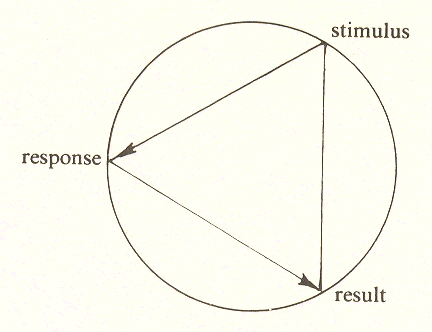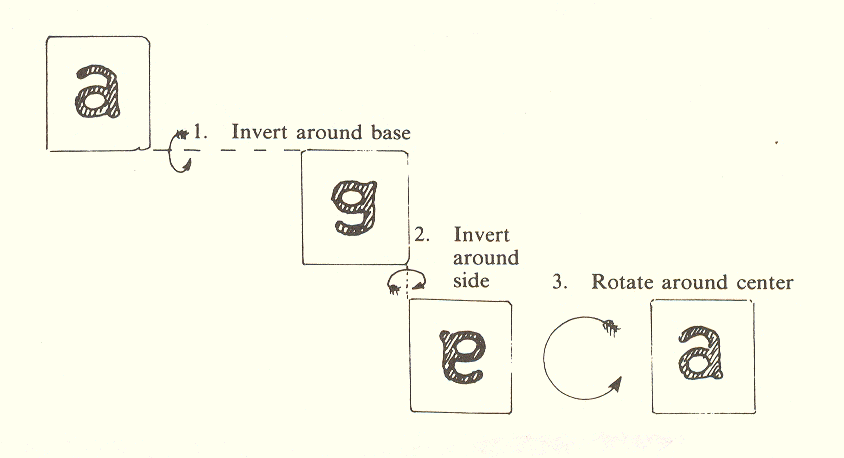
*
THE THREEFOLD DIVISION
In discussing the learning cycle, I implied that fourfold analysis is insufficient as a general description of process. If, for instance, the infant does not encounter a painful experience, but goes on happily reaching for objects, the cycle includes not only actions but other factors as well. This is the threefold cycle of stimulus, response, and result:

The three aspects in this case are again different categories, for which it is quite difficult to find sufficiently general names. In the case of the fourfold analysis, we've seen that response is of four kinds: action, reaction, observation, and control. We will find in due course that "stimulus" is of four kinds, and likewise "result." A stimulus is a relationship between things for instance, between me and my dinner - and, as we shall see later, we would do well to use the more general term "relationship" for this category. "Response" may be similarly generalized by the word "act." And "state" would be a better word than "result," because since the process is circular, what we call result also precedes the stimulus. A state of hunger is the necessary antecedent to the stimulus of food, just as a state of satisfaction will be the result of eating.
So the generalized description of the threefold cycle is:
In returning to a state, which it must do to be a cycle, the process does not necessarily return to the same state that initiated it; it only returns to a state of some kind-in the state category. Similarly, as we said before, the position reached by the operator of a vehicle is not the position from which he started, but is in the position category.
Examples of the threefold
The threefold is not limited to this cycle. In fact, the cycle, as an analytic concept, does not fully describe the threefold. In the more general sense, this is a way by which wholes divide into three interrelated factors, often, but not always, in the form of two elements plus that which is between them. It is a way of interpreting an unlimited variety of ordinary phenomena.
Since it is basically non conceptual, it cannot be defined, so I will try to describe it by means of a few examples.
Time
The most fundamental instance is time. Its factors are:

Time carries with it the idea of movement, whether we think of ourselves as moving through time, or of time as moving through us. There is a compulsive quality about time, a commitment to it, that makes it quite different from distance in space, where we can move in either direction. We cannot travel into the past as we can travel to Chicago and back.
It is the one-wayness or asymmetry of time that makes possible any ordering or temporal succession, like the two directions in which the steps of the cycle of action can occur. Without the asymmetry of time, we could not refer to "before" and "after" without specifying a point of view.
Electricity
The motion of a charge in a field is another example of the threefold. Here the three axes are important, as illustrated by the right-hand rule, which is used to remember the direction of the force (F) on a moving charge, or current of electricity (J), in a magnetic field (B). Note that field --> motion --> force correlates with relationship --> act --> state.
This example has a number of variations:
An electric motor: a moving current in a field creates a force. J + B --> F.
A dynamo: a force on a coil in a field creates a current. F + B --> J.
An ammeter: a current in a field (motion of a charge) again produces a force. J + B --> F.
A magnet: a current creates a field (force is required to keep the wire in place). J + F --> B.
These instances are permutations of the three ingredients we start with A and produce C through B, or B through C, or again, we start with B and produce A through C, etc.
Stability
There are three types of stability or instability, for example, in an aircraft. These are:
1. Phugoid instability, which oscillates:

2. Catastrophic instability, which causes upset:

3. Neutral stability, which doesn't change:
![]()
These are illustrated by:
1. A ball in a bowl:
2. A ball on a convex bump:

3. A ball on a flat surface:

These three kinds of stability are due to displacement of the center of lift (CL) of an airplane with respect to its center of gravity (CG). (For the ball they are due to the relative position of the ball and the center of curvature of the surface.)

1. If the CL is ahead of the CG, measured with respect to wind direction, the airplane will dive and rise, dive and rise.
2. If the CL is behind the CG, the airplane will dive and won't right itself.
3. If the CG is on the CL, the airplane will fly level and remain so.
The permutation of center of gravity and center of lift with respect to wind direction determines the behavior. These three kinds of stability correlate to some extent with the three modes:
Oscillation (phugoid) with relationship
Plunging (catastrophic) with act
Stability with state
Three-ness in cosmogony
Three-ness appears in many religious systems as a trinity of gods; for example, the Brahma, Vishnu, and Shiva in the Hindu tradition. A most interesting one is the Holy Trinity of the Christian religion - God in three persons - Father, Son, and Holy Ghost.
While, as with all threes, there is here an intrinsic movement that shifts the reference as soon as one tries to pin it down, one can at least distinguish a temporal succession. God the Father is the antecedent to any situation (in the past), and God the Son, successor (in the future), leaving God the Holy Ghost, the immanence of God in the present moment. It is through the Holy Ghost that God the Father conceives the Son.
Inversion
Ordinarily, we would expect inversion to be a twofold operation: two inversions return us to the starting point, two minuses make a plus. This is true in terms of the fourfold operator. But when the inversions are in three dimensions of space, it takes three inversions, not two, to get back to the start. Another interesting property is that any two inversions are equal to the third (in the illustration, 1 + 2 = 3, 3 + 2 = 1, 3 + 1 = 2).

Sentence structure
Sentence structure involving subject, verb, and object could be studied as an example of the threefold. The verb, of course, would supply the activity-but only a verb in the present tense; the other tenses are not active. This is offered not as an illustration, but an area for further thought, and warns us of the subtleties of this pre-analytic stage.